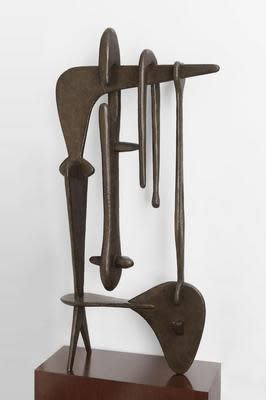-

-
Noguchi’s Important Works and Market
Noguchi once famously said that “to be hybrid anticipates the future.” His prescient view was decades ahead of his time, opening new doors for the development of sculpture into the areas of social functions, environmental awareness and global connection. His furniture and lighting are also recognised as icons of modern design. With a career spanning over six decades, the breadth of Noguchi’s oeuvre is remarkable, and his works are collected by major museums around the world. In M+ collection, besides the play sculptures in the garden, other Noguchi’s works include his iconic Rudder Table, various Akari light sculptures, and Bamboo Basket Chair.

As a sculptor, Noguchi came into fame later than he deserved. His totemic sculptures produced towards the end of the second world war, for instance, Remembrance (1944), Man (1945) and Kouros (1945), were the first series of works that earned him critical recognition. In these abstract sculptures, lone figures are constructed by interlocking planar slabs balancing on each other without fastening, at once alluding to the precarious time of the post-war era and the modular system of modern design.

As noted above, we can often find Noguchi’s sculptures in his furniture designs, and vice versa. His most iconic Herman Miller coffee table (originally created in 1944) has a base that shares the same interlocking feature as his anthropomorphic sculptures; another important design, the Rudder Table (1949), also stands on one planar wooden slab together with two metal hairpin looking legs, instilling a similar sense of precariousness.

Other important works of the artist can be summarised in his solo exhibition “What is Sculpture?” for the U.S. Pavilion at the Venice Biennale in 1986. The most prominent ones were his raw looking stone sculptures which the artist increasing focused on using as found objects later in his career, examples are Beginnings (1985) and Ends (1985). There were also his signature Akari light sculptures which had caused much controversy in the biennale but proved to be a success in both the art scene and design product market even today. Noguchi had designed more than two hundred Akaris since 1951, and each was handmade by the original manufacturer in Gifu, Japan, where the artist first learned the traditional skill of paper lantern making.

As for Noguchi’s market nowadays, his works are constantly present in both art and design auctions and show promising results. In particular, his sculptures are catching up in value with his contemporaries such as Henry Moore and Alexander Calder; and his furniture, due to the small quantity of production, remain rare and highly sought after. Furthermore, it is recently noted that there is an uptick of interest in his legacy in the market thanks to the continuous effort of Isamu Noguchi Foundation and Garden Museum to make his unique artistic vision more visible. The installation in the M+ garden is also a collaboration with the institution. As Hong Kong audience, we are very fortunate to be able to not only view but play with a good collection of works by one of the most important visionaries in art history.
